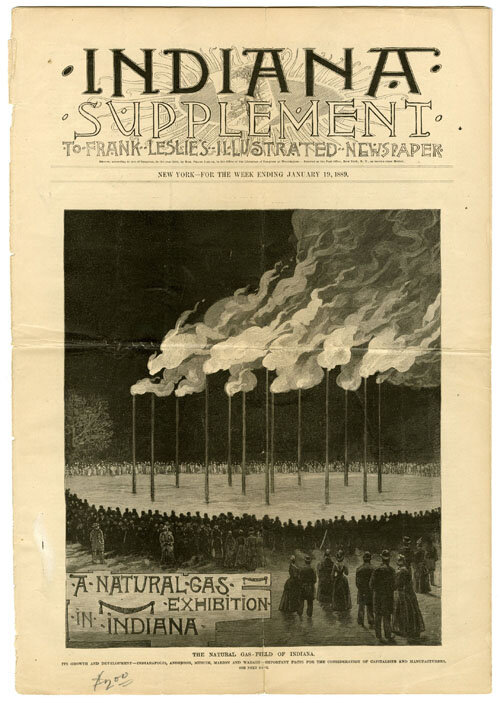The Discovery of Natural Gas Changes the Face of East Central Indiana
Before the discovery of the Trenton Gas Field in the late 19th century, East Central Indiana was almost exclusively an agricultural area. The Gas Boom became a defining moment in the development of the region. Natural gas had an enormous impact on the history, culture, and life of the region and produced a period of economic growth, marked by a dramatic surge in the number of energy-dependent industries that took advantage of the relatively cheap source of fuel to build new factories in the area. Principal among these industries was the manufacturing of glass.
In 1876, George Carter, while looking for coal deposits, bored a two-inch diameter test core close to the railroad track in Eaton, Indiana. At a depth of more than 600 feet, an “ill-smelling gas” was found. The pipe was capped and the discovery forgotten. Ten years later, in 1886, Carter traveled to Findlay, Ohio to view a gas well, part of the recently discovered Trenton Gas Field. He recognized the odor and decided to revisit the site of his “coal mine.” Almeron H. Crannell was hired to drill the well and gas was discovered in East Central Indiana.
This discovery changed the face of the region. Cities such as Muncie, Anderson, Marion, and Kokomo tried to induce companies to move their factories from the east or to build new factories. Free land, free gas, low taxes, and cash were all on the bargaining table. More than 160 factories were established in the Trenton Gas Field region. The factories employed thousands of workers who needed a place to live. Land and homes were purchased from local land developers, making them rich.
All manufacturing operations require energy, especially the glass industry. The soft drink industry had recently exploded onto the scene and window glass was in great demand for new housing. Most importantly, fruit jars were vital to the existence of families in the farmlands of the Midwest.
Many towns used flares as an advertisement for their abundance of natural gas. The flambeaus burned continuously, wasting the precious resource. Prospective factory owners were given the impression that there was an unlimited supply of gas. There wasn’t. Around the turn of the 20th century, gas pressure began to fail. More wells were dug, but the supply of gas continued to dwindle. Eventually, many companies moved west, sold out, went bankrupt, or converted to other sources of energy. The companies that survived often found niche markets. Ball Brothers Company acquired competitors and flourished in the home canning jar industry. Hemingray Glass made insulators for the burgeoning telephone industry. Owens glass controlled the soft drink bottle market.
The discovery of natural gas started the manufacturing boom in East Central Indiana. Even after the gas bust, many skilled factory workers remained as well as other industries, particularly the auto industry, located here.
